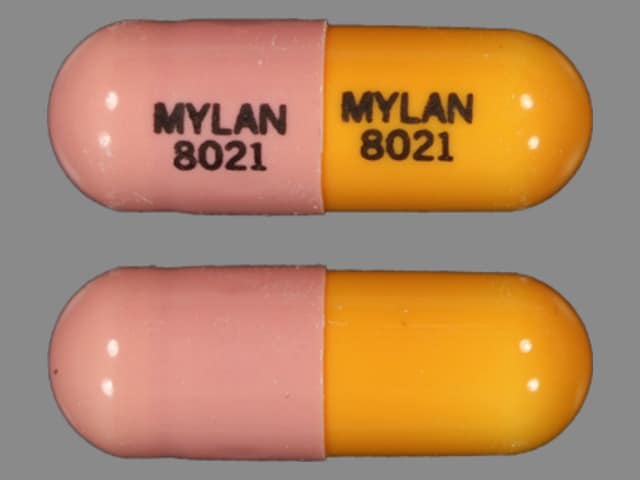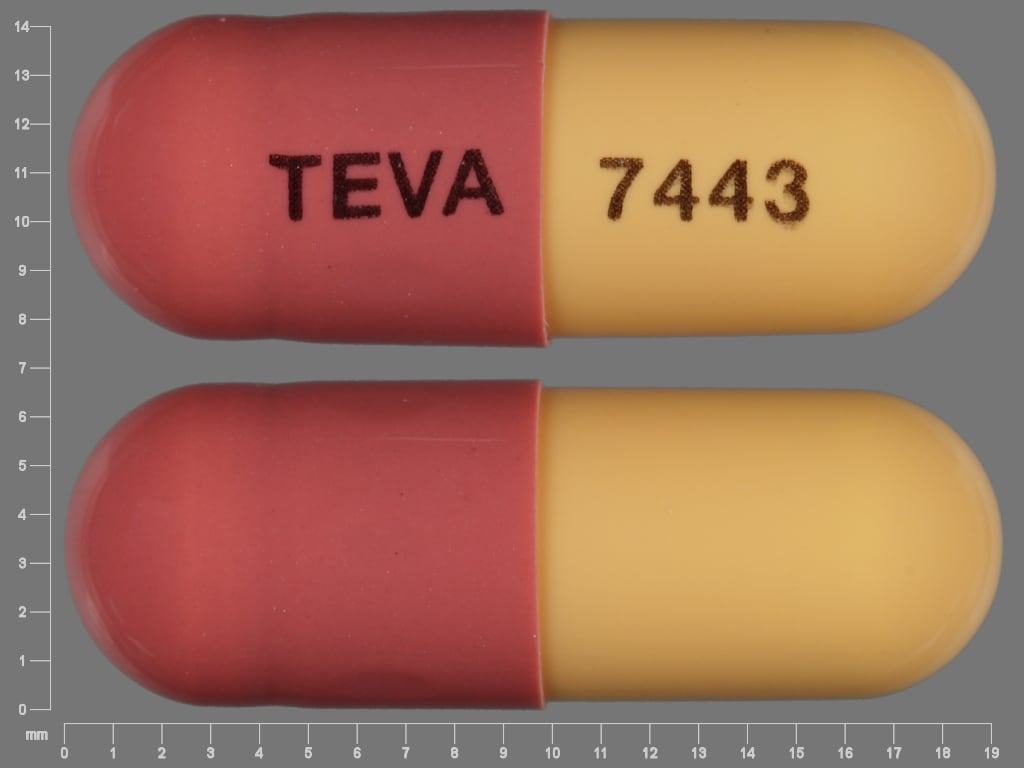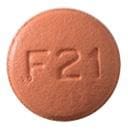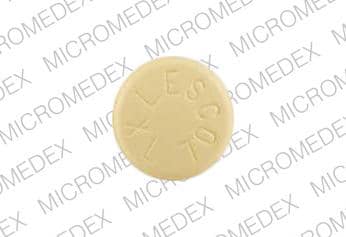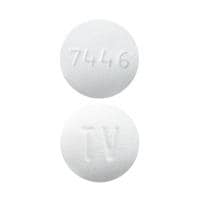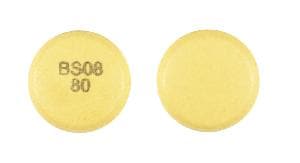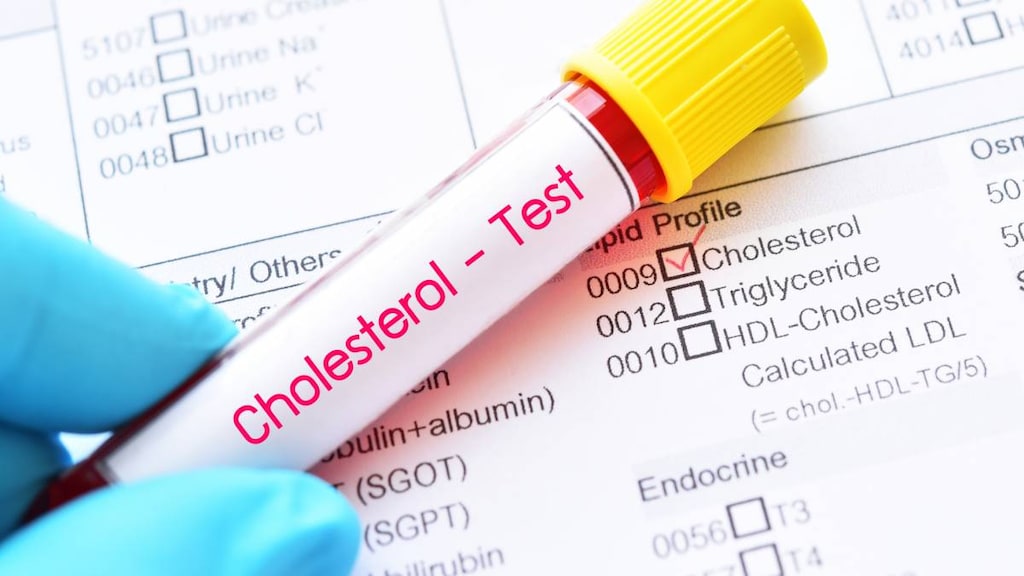Dosage Forms
Excipient information presented when available (limited, particularly for generics); consult specific product labeling.
Capsule, Oral:
Generic: 20 mg, 40 mg
Tablet Extended Release 24 Hour, Oral:
Lescol XL: 80 mg
Generic: 80 mg
Pharmacology
Mechanism of Action
Acts by competitively inhibiting 3-hydroxyl-3-methylglutaryl-coenzyme A (HMG-CoA) reductase, the enzyme that catalyzes the reduction of HMG-CoA to mevalonate; this is an early rate-limiting step in cholesterol biosynthesis. HDL is increased while total, LDL, and VLDL cholesterols; apolipoprotein B; and plasma triglycerides are decreased. In addition to the ability of HMG-CoA reductase inhibitors to decrease levels of high-sensitivity C-reactive protein (hsCRP), they also possess pleiotropic properties including improved endothelial function, reduced inflammation at the site of the coronary plaque, inhibition of platelet aggregation, and anticoagulant effects (de Denus 2002; Ray 2005).
Pharmacokinetics/Pharmacodynamics
Distribution
Vdss: 0.35 L/kg
Metabolism
Hepatic to inactive and active metabolites (oxidative metabolism via CYP2C9 [~75%], CYP2C8 [~5%], and CYP3A4 [~20%] isoenzymes); active forms do not circulate systemically; extensive (saturable) first-pass hepatic extraction
Excretion
Excretion: Feces (~90%; <2% unchanged); urine (~5%)
Onset of Action
Peak effect: Maximal LDL-C reductions achieved within 4 weeks
Time to Peak
Immediate-release: <1 hour (delayed more than 2-fold when administered with food as compared to administering 4 hours after the evening meal)
Extended-release: ~3 hours (minimally affected by low-fat meals; however, with a high-fat meal, delayed by 2-fold)
Half-Life Elimination
Immediate-release: ~3 hours; Extended-release: 7.3 to 10.5 hours (due to prolonged absorption time) (Barilla 2004)
Protein Binding
98%
Use in Specific Populations
Special Populations: Renal Function Impairment
In moderate to severe renal impairment (CrCl 10 to 40 mL/minute), AUC and Cmax increased ~1.2-fold after administration of a single dose of 40 mg immediate-release fluvastatin; in ESRD on hemodialysis, the AUC increased ~1.5-fold.
Special Populations: Hepatic Function Impairment
AUC and Cmax increase ~2.5-fold after administration of a single dose of 40 mg immediate-release fluvastatin.
Use: Labeled Indications
Dyslipidemias:
Heterozygous familial and nonfamilial hypercholesterolemia and mixed dyslipidemia: Adjunct to diet to reduce elevated total cholesterol (total-C), low-density lipoprotein-cholesterol (LDL-C), triglyceride, and apolipoprotein B (apo-B) levels and to increase HDL-C in adults with primary hypercholesterolemia and mixed dyslipidemia (Fredrickson types IIa and IIb)
Heterozygous familial hypercholesterolemia: As an adjunct to diet to reduce total-C, LDL-C, and apo B levels in children ≥10 years and adolescents ≤16 years of age (female patients must be at least 1 year postmenarche) with heterozygous familial hypercholesterolemia and an LDL-C that remains ≥190 mg/dL or ≥160 mg/dL (with ≥2 cardiovascular risk factors or a positive family history of premature cardiovascular disease).
Prevention of cardiovascular disease (CVD):
Secondary prevention of CVD: To slow the progression of coronary atherosclerosis in patients with coronary heart disease; reduce risk of coronary revascularization procedures in patients with coronary heart disease
Limitations of use: Has not been studied in conditions where the major abnormality is elevation of chylomicrons, very low-density lipoprotein (VLDL), or intermediate density lipoprotein (IDL) (ie, hyperlipoproteinemia types I, III, IV, or V).
Use: Off Label
Cardiac risk reduction for noncardiac surgery (perioperative therapy)yes
Based on the 2014 American College of Cardiology/American Heart Association (ACC/AHA) guidelines on perioperative cardiovascular evaluation and management of patients undergoing noncardiac surgery, perioperative initiation of statins is reasonable for patients undergoing vascular surgery and may be considered in patients with clinical indications according to guideline-directed medical therapy who are undergoing elevated risk procedures. In patients undergoing non-cardiac surgery who are currently receiving a statin, the statin should be continued.
Noncardioembolic stroke/TIA (secondary prevention)yes
Based on the American Heart Association/American Stroke Association (AHA/ASA) guidelines for the prevention of stroke in patients with stroke and transient ischemic attack, statin therapy with intensive lipid-lowering effects is recommended to reduce the risk of recurrent stroke and future cardiovascular events in patients with ischemic stroke or TIA presumed to be of atherosclerotic origin who have an LDL-C concentration ≥100 mg/dL (with or without evidence for other clinical atherosclerotic cardiovascular disease [ASCVD]) or who have an LDL-C concentration <100 mg/dL (without evidence for other clinical ASCVD).
Contraindications
Hypersensitivity to fluvastatin or any component of the formulation; active liver disease; unexplained persistent elevations of serum transaminases; pregnancy or women planning to become pregnant; breastfeeding
Dosage and Administration
Dosing: Adult
Heterozygous familial and nonfamilial hypercholesterolemia: Oral:
Immediate release: 40 mg once daily in the evening or 40 mg twice daily
Extended release: 80 mg once daily (anytime)
Mixed dyslipidemia: Oral:
Immediate release: 40 mg once daily in the evening or 40 mg twice daily
Extended release: 80 mg once daily (anytime)
Patients requiring ≥25% decrease in LDL-C: Oral:
Immediate release: Initial: 40 mg once daily in the evening or 40 mg twice daily
Extended release: Initial: 80 mg once daily (anytime)
Patients requiring <25% decrease in LDL-C: Oral: Initial: Immediate release: 20 mg once daily in the evening; may increase based on tolerability and response to a maximum recommended dose of 80 mg/day, given in 2 divided doses (immediate release) or as a single daily dose (extended release)
Prevention of cardiovascular disease/reduce the risk of atherosclerotic cardiovascular disease: Oral:
ACC/AHA Blood Cholesterol Guideline recommendations (ACC/AHA [Grundy 2018]; ACC/AHA [Stone 2013]):
Note: When choosing to initiate therapy and selecting dose-intensity, consider atherosclerotic cardiovascular disease (ASCVD) risk, risk-enhancing factors, possibility for side effects, and drug interactions.
Primary prevention:
LDL-C ≥190 mg/dL and age 20 to 75 years: High-intensity therapy necessary; use alternate statin therapy (eg, atorvastatin or rosuvastatin)
Diabetes, age 40 to 75 years, and an estimated 10-year ASCVD risk <7.5%: Moderate-intensity therapy:
Immediate release: 40 mg twice daily.
Extended release: 80 mg once daily.
Diabetes, age 40 to 75 years, and an estimated 10-year ASCVD risk ≥7.5%: High-intensity therapy necessary; use alternate statin therapy (eg, atorvastatin or rosuvastatin).
LDL-C 70 to 189 mg/dL, age 40 to 75 years, and an estimated 10-year ASCVD risk ≥7.5%: Moderate- to high-intensity therapy:
Immediate release: 40 mg twice daily or consider using high-intensity statin therapy (eg, atorvastatin or rosuvastatin).
Extended release: 80 mg once daily or consider using high-intensity statin therapy (eg, atorvastatin or rosuvastatin).
Secondary prevention:
Patient has clinical ASCVD (eg, coronary heart disease, stroke/TIA, or peripheral arterial disease presumed to be of atherosclerotic origin) or is post-CABG (AHA [Kulik 2015]) and:
Age ≤75 years: High-intensity therapy necessary; use alternate statin therapy (eg, atorvastatin or rosuvastatin).
Age >75 years: Moderate- to high-intensity therapy:
Immediate release: 40 mg twice daily or consider using high-intensity statin therapy (eg, atorvastatin or rosuvastatin); if moderate-intensity therapy is started and tolerated, increase to a high-intensity statin therapy within 3 months (Rosenson 2019).
Extended release: 80 mg once daily or consider using high-intensity statin therapy (eg, atorvastatin or rosuvastatin); if moderate-intensity therapy is started and tolerated, increase to a high-intensity statin therapy within 3 months (Rosenson 2019).
US Preventive Services Task Force Recommendations (USPSTF 2016): Age 40 to 75 years, no history of CVD, with ≥1 CVD risk factor (dyslipidemia, diabetes, hypertension, or smoking), and calculated 10-year CVD event risk of ≥10%:
Primary prevention:
Low-intensity therapy:
Immediate release: 20 to 40 mg once daily
Moderate-intensity therapy:
Immediate release: 40 mg twice daily
Extended release: 80 mg once daily
Note: These recommendations do not pertain to patients with very high cholesterol levels (eg, LDL >190 mg/dL, familial hypercholesterolemia) (were excluded from primary prevention trials); use clinical judgment in the treatment of these patients. In patients with a calculated 10-year CVD event risk of 7.5% to 10%, statin use may be considered based on patient characteristics.
Concomitant use with cyclosporine or fluconazole: Immediate release: Do not exceed fluvastatin 20 mg twice daily
Dosing: Geriatric
Refer to adult dosing.
Dosing: Pediatric
Hyperlipidemia or heterozygous familial and nonfamilial hypercholesterolemia: Note: Begin treatment if after adequate trial of diet the following are present: LDL-C ≥190 mg/dL or LDL-C remains ≥160 mg/dL and positive family history of premature cardiovascular disease or meets NCEP classification (NHLBI 2011). Therapy may be considered for children 8-9 years of age meeting the above criteria or for children with diabetes mellitus and LDL-C ≥130 mg/dL (Daniels 2008).
Children ≥10 years and Adolescents ≤16 years (female patients should be ≥1 year postmenarche): Oral:
Immediate release capsule: Initial: 20 mg once daily; may titrate dose or frequency (twice daily dosing) at 6-week intervals; maximum dose: 40 mg twice daily
Extended release tablet: Should not be used to initiate therapy; may convert patient if total daily dose is 80 mg/day
Dosing adjustment for fluvastatin with concomitant medications: Children and Adolescents:
Cyclosporine, fluconazole: Do not exceed 20 mg twice daily
Dosing adjustment for toxicity: Muscle symptoms (potential myopathy): Children ≥10 years and Adolescents: Discontinue use until symptoms can be evaluated; check creatine phosphokinase (CPK) level; based on experience in adult patients, also evaluate patient for conditions that may increase the risk for muscle symptoms (eg, hypothyroidism, reduced renal or hepatic function, rheumatologic disorders such as polymyalgia rheumatica, steroid myopathy, vitamin D deficiency, or primary muscle diseases). Upon resolution (symptoms and any associated CPK abnormalities), resume the original or consider a lower dose of fluvastatin and retitrate. If muscle symptoms recur, discontinue fluvastatin use. After muscle symptom resolution, may then reinitiate a different statin at an initial low dose; gradually increase if tolerated. Based on experience in adult patients, if muscle symptoms or elevated CPK persists for 2 months in the absence of continued statin use, consider other causes of muscle symptoms. If determined to be due to another condition aside from statin use, may resume statin therapy at the original dose (NHLBI 2011; Stone 2013).
Dosing: Adjustment for Toxicity
Severe muscle symptoms or fatigue: Promptly discontinue use; evaluate CPK, creatinine, and urinalysis for myoglobinuria (ACC/AHA [Stone 2013]).
Mild to moderate muscle symptoms: Discontinue use until symptoms can be evaluated; evaluate patient for conditions that may increase the risk for muscle symptoms (eg, hypothyroidism, reduced renal or hepatic function, rheumatologic disorders such as polymyalgia rheumatica, steroid myopathy, vitamin D deficiency, or primary muscle diseases). Upon resolution, resume the original or lower dose of fluvastatin. If muscle symptoms recur, discontinue fluvastatin use. After muscle symptom resolution, may then use a low dose of a different statin; gradually increase if tolerated. In the absence of continued statin use, if muscle symptoms or elevated CPK continues after 2 months, consider other causes of muscle symptoms. If determined to be due to another condition aside from statin use, may resume statin therapy at the original dose (ACC/AHA [Stone 2013]).
Administration
Oral: Patient should be placed on a standard cholesterol-lowering diet before and during treatment. Administer without regard to meals. Do not break, chew, or crush extended release tablets; do not open immediate-release capsules. Do not administer two 40 mg immediate-release capsules at once.
Dietary Considerations
Generally, patients should be placed on a standard cholesterol-lowering diet and other lifestyle modifications for 3 to 6 months prior to the initiation of drug therapy. The diet should be continued during drug therapy. However, for patients with advanced risk factors (eg, known coronary heart disease), drug therapy may be initiated concurrently with diet modification.
Red yeast rice contains variable amounts of several compounds that are structurally similar to HMG-CoA reductase inhibitors, primarily monacolin K (or mevinolin) which is structurally identical to lovastatin; concurrent use of red yeast rice with HMG-CoA reductase inhibitors may increase the incidence of adverse and toxic effects (Lapi 2008; Smith 2003).
Storage
Store at 25°C (77°F); excursions permitted to 15°C to 30°C (59°F to 86°F). Protect from light.
Fluvastatin Images
Drug Interactions
Acipimox: May enhance the myopathic (rhabdomyolysis) effect of HMG-CoA Reductase Inhibitors (Statins). Monitor therapy
Asunaprevir: May increase the serum concentration of HMG-CoA Reductase Inhibitors (Statins). Monitor therapy
Atazanavir: May increase the serum concentration of Fluvastatin. Consider therapy modification
Bezafibrate: May enhance the myopathic (rhabdomyolysis) effect of HMG-CoA Reductase Inhibitors (Statins). Bezafibrate may increase the serum concentration of HMG-CoA Reductase Inhibitors (Statins). More specifically, bezafibrate may increase the serum concentration of fluvastatin Management: Monitor patients closely for myopathy with concomitant use of bezafibrate and HMG-CoA reductase inhibitors. Concomitant use is contraindicated in patients predisposed to myopathy and alternative therapy should be considered. Consider therapy modification
Cholestyramine Resin: May decrease the serum concentration of Fluvastatin. Management: Administer fluvastatin at least 1 hour or greater (particularly with extended-release form) before, or at least 4 hours after cholestyramine to minimize the risk for any significant interaction. Consider therapy modification
Ciprofibrate: May enhance the adverse/toxic effect of HMG-CoA Reductase Inhibitors (Statins). Management: Avoid the use of HMG-CoA reductase inhibitors and ciprofibrate if possible. If concomitant therapy is considered, benefits should be carefully weighed against the risks, and patients should be monitored closely for signs/symptoms of muscle toxicity. Consider therapy modification
Cobicistat: May increase the serum concentration of Fluvastatin. Monitor therapy
Colchicine: May enhance the myopathic (rhabdomyolysis) effect of HMG-CoA Reductase Inhibitors (Statins). Colchicine may increase the serum concentration of HMG-CoA Reductase Inhibitors (Statins). Consider therapy modification
CycloSPORINE (Systemic): May increase the serum concentration of Fluvastatin. Management: Limit fluvastatin to 20 mg twice daily in patients who are also receiving cyclosporine. Consider therapy modification
CYP2C9 Inhibitors (Moderate): May decrease the metabolism of CYP2C9 Substrates (High risk with Inhibitors). Monitor therapy
Cyproterone: May increase the serum concentration of HMG-CoA Reductase Inhibitors (Statins). Management: Avoid use of statins metabolized by CYP3A4 (eg, simvastatin) and consider avoiding fluvastatin as well in patients receiving high dose cyproterone (300 mg/day). Consider use of pravastatin, rosuvastatin, or pitavastatin if statin therapy is needed. Consider therapy modification
Daclatasvir: May increase the serum concentration of HMG-CoA Reductase Inhibitors (Statins). Monitor therapy
DAPTOmycin: HMG-CoA Reductase Inhibitors (Statins) may enhance the adverse/toxic effect of DAPTOmycin. Specifically, the risk of skeletal muscle toxicity may be increased. Management: Consider temporarily stopping HMG-CoA reductase inhibitor therapy prior to daptomycin. If used together, regular (i.e., at least weekly) monitoring of CPK concentrations is recommended. Consider therapy modification
Elbasvir: May increase the serum concentration of Fluvastatin. Monitor therapy
Eltrombopag: May increase the serum concentration of OATP1B1/1B3 (SLCO1B1/1B3) Substrates. Monitor therapy
Etravirine: May increase the serum concentration of Fluvastatin. Monitor therapy
Fenofibrate and Derivatives: May enhance the adverse/toxic effect of HMG-CoA Reductase Inhibitors (Statins). Monitor therapy
Fluconazole: May increase the serum concentration of Fluvastatin. Management: Limit fluvastatin maximum adult dose to 20 mg twice daily, and monitor for toxic effects of fluvastatin (e.g., myalgia, rhabdomyolysis, liver function test abnormalities), during concomitant treatment. Consider therapy modification
Fosphenytoin: May decrease the serum concentration of HMG-CoA Reductase Inhibitors (Statins). Consider therapy modification
Fusidic Acid (Systemic): May enhance the adverse/toxic effect of HMG-CoA Reductase Inhibitors (Statins). Specifically, the risk for muscle toxicities, including rhabdomyolysis may be significantly increased. Management: Avoid concurrent use whenever possible. Use is listed as contraindicated in product characteristic summaries in several countries, although UK labeling suggests that use could be considered under exceptional circumstances and with close supervision. Avoid combination
Gemfibrozil: May enhance the myopathic (rhabdomyolysis) effect of Fluvastatin. Avoid combination
Glecaprevir and Pibrentasvir: May increase the serum concentration of HMG-CoA Reductase Inhibitors (Statins). Management: Use the lowest statin dose possible if combined with glecaprevir/pibrentasvir and monitor for increased statin effects/toxicities. Avoid concomitant use with atorva-, simva-, or lovastatin. Limit rosuvastatin to 10 mg daily and reduce pravastatin dose 50% Consider therapy modification
Grazoprevir: May increase the serum concentration of Fluvastatin. Monitor therapy
Lanthanum: HMG-CoA Reductase Inhibitors (Statins) may decrease the serum concentration of Lanthanum. Management: Administer HMG-CoA reductase inhibitors at least two hours before or after lanthanum. Consider therapy modification
Letermovir: May increase the serum concentration of HMG-CoA Reductase Inhibitors (Statins). Monitor therapy
Lumacaftor and Ivacaftor: May decrease the serum concentration of CYP2C9 Substrates (High Risk with Inhibitors or Inducers). Lumacaftor and Ivacaftor may increase the serum concentration of CYP2C9 Substrates (High Risk with Inhibitors or Inducers). Monitor therapy
MiFEPRIStone: May increase the serum concentration of Fluvastatin. Management: Use fluvastatin at the lowest recommended dose, and monitor closely for adverse effects (including myopathy), during and in the 2 weeks following mifepristone treatment. Consider therapy modification
Niacin: May enhance the adverse/toxic effect of HMG-CoA Reductase Inhibitors (Statins). Monitor therapy
Niacinamide: May enhance the adverse/toxic effect of HMG-CoA Reductase Inhibitors (Statins). Monitor therapy
Ombitasvir, Paritaprevir, Ritonavir, and Dasabuvir: May increase the serum concentration of Fluvastatin. Management: Canadian product labeling recommends use of the lowest fluvastatin dose with this combination. Monitor therapy
Phenytoin: May decrease the serum concentration of HMG-CoA Reductase Inhibitors (Statins). Consider therapy modification
Raltegravir: May enhance the myopathic (rhabdomyolysis) effect of HMG-CoA Reductase Inhibitors (Statins). Monitor therapy
Red Yeast Rice: May enhance the adverse/toxic effect of HMG-CoA Reductase Inhibitors (Statins). Avoid combination
Repaglinide: HMG-CoA Reductase Inhibitors (Statins) may increase the serum concentration of Repaglinide. Monitor therapy
Rifamycin Derivatives: May decrease the serum concentration of HMG-CoA Reductase Inhibitors (Statins). Management: Consider use of noninteracting antilipemic agents (note: pitavastatin concentrations may increase with rifamycin treatment). Monitor for altered HMG-CoA reductase inhibitor effects. Rifabutin and fluvastatin, or possibly pravastatin, may pose lower risk. Consider therapy modification
Rupatadine: May enhance the adverse/toxic effect of HMG-CoA Reductase Inhibitors (Statins). Specifically, the risk for increased CPK and/or other muscle toxicities may be increased. Monitor therapy
Teriflunomide: May increase the serum concentration of OATP1B1/1B3 (SLCO1B1/1B3) Substrates. Monitor therapy
Tolvaptan: May increase the serum concentration of OATP1B1/1B3 (SLCO1B1/1B3) Substrates. Consider therapy modification
Trabectedin: HMG-CoA Reductase Inhibitors (Statins) may enhance the myopathic (rhabdomyolysis) effect of Trabectedin. Monitor therapy
Vitamin K Antagonists (eg, warfarin): HMG-CoA Reductase Inhibitors (Statins) may enhance the anticoagulant effect of Vitamin K Antagonists. Monitor therapy
Voxilaprevir: May increase the serum concentration of HMG-CoA Reductase Inhibitors (Statins). Management: Use the lowest statin dose possible if combined with voxilaprevir and monitor patients for increased statin effects/toxicities. Avoid concomitant use of voxilaprevir with rosuvastatin or pitavastatin, and limit pravastatin doses to 40 mg daily. Consider therapy modification
Adverse Reactions
Frequency not always defined. The following adverse events were reported with fluvastatin capsules; in general, adverse reactions reported with fluvastatin extended release tablet were similar, but incidences were lower. <1%/Postmarketing adverse reactions include additional class-related events that were not necessarily reported with fluvastatin therapy.
1% to 10%:
Central nervous system: Headache (9%), fatigue (3%), insomnia (3%)
Gastrointestinal: Dyspepsia (8%), abdominal pain (5%), diarrhea (5%), nausea (3%)
Genitourinary: Urinary tract infection (2%)
Neuromuscular & skeletal: Myalgia (5%)
Respiratory: Sinusitis (3%), bronchitis (2%)
<1%, postmarketing, and/or case reports: Alopecia, amnesia (reversible), anaphylaxis, angioedema, anorexia, anxiety, arthralgia, arthritis, blurred vision, cataract, changes in nails, chills, cholestatic jaundice, cognitive dysfunction (reversible), cystitis (interstitial; Huang 2015), decreased libido, depression, dermatomyositis, dizziness, dry mucous membranes, dysgeusia, dyspnea, elevated glycosylated hemoglobin (HbA1c), eosinophilia, erectile dysfunction, erythema multiforme, facial paresis, fever, flushing, fulminant hepatic necrosis, gynecomastia, hemolytic anemia, hepatic cirrhosis, hepatic neoplasm, hepatitis, hyperbilirubinemia, hypersensitivity reaction, immune-mediated necrotizing myopathy (IMNM), impairment of extraocular movement, impotence, increased creatine phosphokinase (>10x normal), increased erythrocyte sedimentation rate, increased gamma-glutamyl transferase, increased serum alkaline phosphatase, increased serum glucose, increased serum transaminases, interstitial pulmonary disease, leukopenia, liver steatosis, lupus-like syndrome, malaise, memory impairment (reversible), muscle cramps, myopathy, nodule, ophthalmoplegia, pancreatitis, paresthesia, peripheral nerve palsy, peripheral neuropathy, polymyalgia rheumatica, positive ANA titer, pruritus, psychic disorder, purpura, reversible confusional state, rhabdomyolysis, skin discoloration, skin photosensitivity, skin rash, Stevens-Johnson syndrome, thrombocytopenia, thyroid dysfunction, toxic epidermal necrolysis, tremor, urticaria, vasculitis, vertigo, vomiting, xeroderma
Warnings/Precautions
Concerns related to adverse effects:
- Diabetes mellitus: Increases in HbA1c and fasting blood glucose have been reported with HMG-CoA reductase inhibitors; however, the benefits of statin therapy (eg, reduction in the risk of MI or stroke) far outweigh the risk of dysglycemia. If a patient develops diabetes mellitus during therapy, continue use of fluvastatin and encourage patient to adhere to healthy lifestyle regimens (eg, heart healthy dietary pattern, engage in physical activity, achieve and maintain a healthy body weight) (ACC/AHA [Stone 2013]).
- Hepatotoxicity: Increased AST or ALT has been reported; in most cases, elevations were transient and resolved or improved on continued therapy or after a brief interruption in therapy. Postmarketing reports of fatal and nonfatal hepatic failure have been reported and are rare. If serious hepatotoxicity with clinical symptoms and/or hyperbilirubinemia or jaundice occurs during treatment, interrupt therapy promptly. If an alternate etiology is not identified, do not restart fluvastatin. Possible drug-related hepatitis (rare) was observed that resolved upon discontinuation of treatment. Liver enzyme tests should be obtained at baseline and as clinically indicated and if signs/symptoms of liver injury occur. Ethanol may enhance the potential of adverse hepatic effects; instruct patients to avoid excessive ethanol consumption. Use has been found to be safe in those with active hepatitis C (Kondo 2012; Kurincic 2014).
- Myopathy/rhabdomyolysis: Rhabdomyolysis with acute renal failure secondary to myoglobinuria and/or myopathy has been reported; patients should be monitored closely. This risk is dose related and is increased with concurrent use of cyclosporine, erythromycin, or other lipid-lowering medications (eg, fibrates, niacin at doses ≥1 g/day). Use caution in patients with inadequately treated hypothyroidism, and those taking other drugs associated with myopathy (eg, colchicine); these patients are predisposed to myopathy. Immune-mediated necrotizing myopathy (IMNM) associated with HMG-CoA reductase inhibitors use has also been reported. Patients should be instructed to report unexplained muscle pain, tenderness, weakness, or brown urine, particularly if accompanied by malaise or fever. Discontinue therapy if markedly elevated CPK levels occur or myopathy is diagnosed/suspected.
Disease-related concerns:
- Diseases reducing steroidogenesis: Use caution in patients with conditions or on medications that reduce steroidogenesis.
- Hepatic impairment and/or ethanol use: Use with caution in patients who consume large amounts of ethanol or have a history of liver disease. Use is contraindicated in patients with active liver disease or unexplained transaminase elevations.
- Renal impairment: Use with caution in patients with renal impairment; these patients are predisposed to myopathy.
Concurrent drug therapy issues:
- Drug-drug interactions: Potentially significant interactions may exist, requiring dose or frequency adjustment, additional monitoring, and/or selection of alternative therapy. Consult drug interactions database for more detailed information.
Special populations:
- Elderly: Use with caution in patients with advanced age; these patients are predisposed to myopathy.
- Surgical patients: The manufacturer recommends temporary discontinuation for elective major surgery, acute medical or surgical conditions, or in any patient experiencing an acute or serious condition predisposing to renal failure secondary to rhabdomyolysis (eg, sepsis, hypotension, trauma, uncontrolled seizures, severe metabolic, endocrine, or electrolyte disorders). Based on current research and clinical guidelines, HMG-CoA reductase inhibitors should be continued in the perioperative period for noncardiac and cardiac surgery (ACC/AHA [Hillis 2011]; ACC/AHA [Fleisher 2014]). Perioperative discontinuation of statin therapy is associated with an increased risk of cardiac morbidity and mortality.
Other warnings/precautions:
- Appropriate use: Drug therapy should be only one component of multiple risk factor intervention in patients at significantly increased risk for atherosclerotic vascular disease due to hypercholesterolemia. In patients with CHD or multiple risk factors for CHD, initiate therapy simultaneously with diet.
- Hyperlipidemia: Secondary causes of hyperlipidemia should be ruled out prior to therapy.
Monitoring Parameters
ACC/AHA Blood Cholesterol Guideline recommendations (ACC/AHA [Grundy 2018]; ACC/AHA [Stone 2013]):
Lipid panel (total cholesterol, HDL, LDL, triglycerides): Lipid profile (fasting or nonfasting) before initiating treatment. Fasting lipid profile should be rechecked 4 to 12 weeks after starting therapy and every 3 to 12 months thereafter. If 2 consecutive LDL levels are <40 mg/dL, consider decreasing the dose.
Hepatic transaminase levels: Baseline measurement of hepatic transaminase levels (AST and ALT); measure AST, ALT, total bilirubin, and alkaline phosphatase if symptoms suggest hepatotoxicity (eg, unusual fatigue or weakness, loss of appetite, abdominal pain, dark-colored urine or yellowing of skin or sclera) during therapy.
CPK: CPK should not be routinely measured. Baseline CPK measurement is reasonable for some individuals (eg, family history of statin intolerance or muscle disease, clinical presentation, concomitant drug therapy that may increase risk of myopathy). May measure CPK in any patient with symptoms suggestive of myopathy (pain, tenderness, stiffness, cramping, weakness, or generalized fatigue).
Evaluate for new-onset diabetes mellitus during therapy; if diabetes develops, continue statin therapy and encourage adherence to a heart-healthy diet, physical activity, a healthy body weight, and tobacco cessation.
If patient develops a confusional state or memory impairment, may evaluate patient for nonstatin causes (eg, exposure to other drugs), systemic and neuropsychiatric causes, and the possibility of adverse effects associated with statin therapy.
Pregnancy
Pregnancy Risk Factor
X
Pregnancy Considerations
Fluvastatin is contraindicated in pregnant females or those who may become pregnant.
Studies in pregnant women have shown evidence of fetal abnormalities and use is contraindicated in women who are or may become pregnant. There are reports of congenital anomalies following maternal use of HMG-CoA reductase inhibitors in pregnancy; however, maternal disease, differences in specific agents used, and the low rates of exposure limit the interpretation of the available data (Godfrey 2012; Lecarpentier 2012). Cholesterol biosynthesis may be important in fetal development; serum cholesterol and triglycerides increase normally during pregnancy. The discontinuation of lipid lowering medications temporarily during pregnancy is not expected to have significant impact on the long term outcomes of primary hypercholesterolemia treatment.
Fluvastatin should be discontinued immediately if an unplanned pregnancy occurs during treatment.
Adequate contraception is recommended if an HMG-CoA reductase inhibitor is required in females of reproductive potential. Females planning a pregnancy should discontinue the HMG-CoA reductase inhibitor 1 to 2 months prior to attempting to conceive (AHA/ACC [Grundy 2018]).
Patient Education
What is this drug used for?
- It is used to lower bad cholesterol and raise good cholesterol (HDL).
- It is used to lower triglycerides.
- It is used to slow the progress of heart disease.
- It may be given to you for other reasons. Talk with the doctor.
Frequently reported side effects of this drug
- Abdominal pain
- Nausea
- Loss of strength and energy
- Diarrhea
- Trouble sleeping
- Flu-like symptoms
Other side effects of this drug: Talk with your doctor right away if you have any of these signs of:
- Liver problems like dark urine, fatigue, lack of appetite, nausea, abdominal pain, light-colored stools, vomiting, or yellow skin
- Severe headache
- Change in balance
- Trouble with memory
- Confusion
- Unable to pass urine
- Change in amount of urination
- Painful urination
- Severe muscle pain
- Severe muscle weakness
- Severe muscle tenderness
- Signs of a significant reaction like wheezing; chest tightness; fever; itching; bad cough; blue skin color; seizures; or swelling of face, lips, tongue, or throat.
Note: This is not a comprehensive list of all side effects. Talk to your doctor if you have questions.
Consumer Information Use and Disclaimer: This information should not be used to decide whether or not to take this medicine or any other medicine. Only the healthcare provider has the knowledge and training to decide which medicines are right for a specific patient. This information does not endorse any medicine as safe, effective, or approved for treating any patient or health condition. This is only a brief summary of general information about this medicine. It does NOT include all information about the possible uses, directions, warnings, precautions, interactions, adverse effects, or risks that may apply to this medicine. This information is not specific medical advice and does not replace information you receive from the healthcare provider. You must talk with the healthcare provider for complete information about the risks and benefits of using this medicine.
